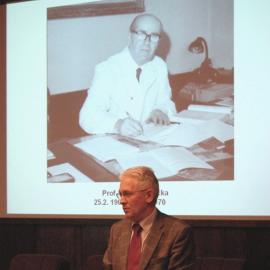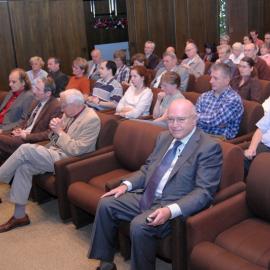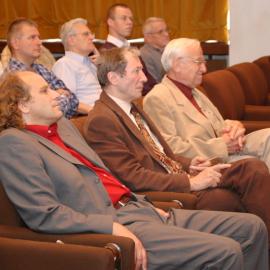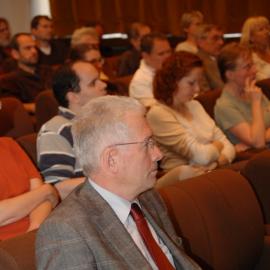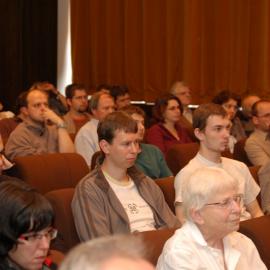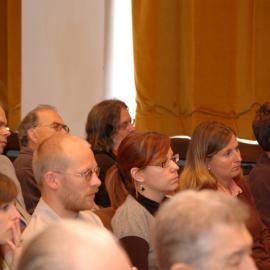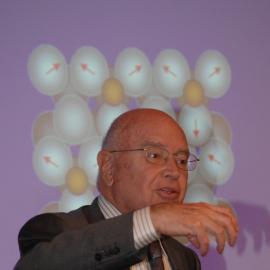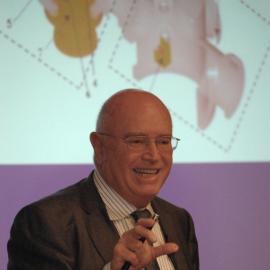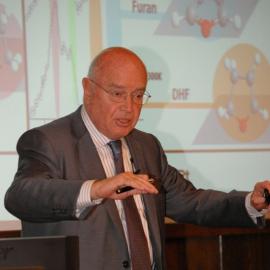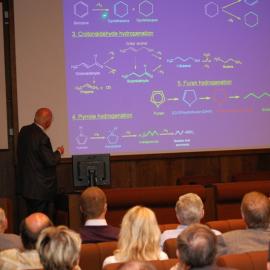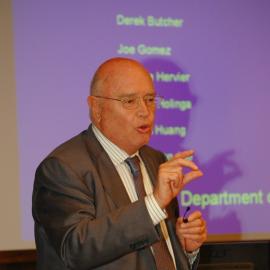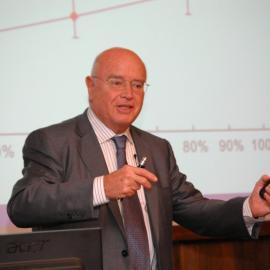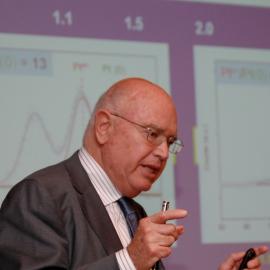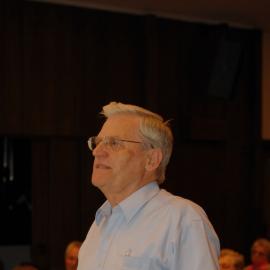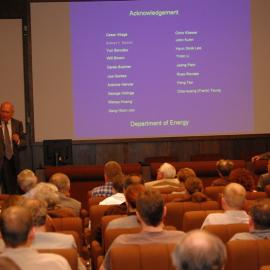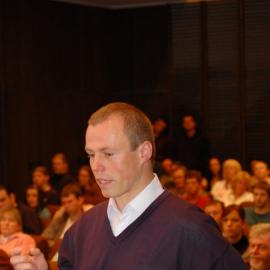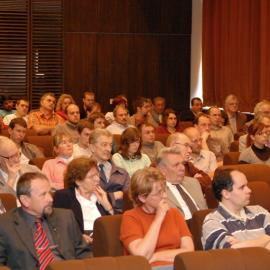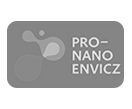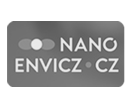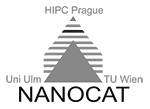Gabor A. Somorjai (University of California at Berkeley)
Lecture Type
Year
2009
The annual R.Brdicka lecture was held on June 25, 2009 at 10:00 in R. Brdicka hall.
MOLECULAR FOUNDATIONS OF HETEROGENEOUS METAL CATALYSIS
Gabor A. Somorjai
Department of Chemistry and Lawrence Berkeley National Laboratory
University of California, Berkeley
Heterogeneous metal catalysts are nanoparticles that carry out reactions at high reactant gas pressures or in the liquid phase. Instruments developed in Berkeley for molecular studies under these conditions are sum frequency generation vibrational spectroscopy, high pressure scanning tunneling microscopy and ambient pressure X-ray photoelectron spectroscopy. Model surfaces were used to study heterogeneous catalytic reactions that permitted to control and monitor the atomic surface structure, composition and reaction intermediates and simultaneously measure reaction rates and selectivities. This way precise quantitative correlations could be obtained between catalytic reaction kinetics and the molecular factors that control reaction dynamics. Single crystal surfaces were used at first as model catalysts followed by the use of metal and bimetallic nanoparticles that were synthesized with precise size and shape using colloid techniques. Catalytic studies that produce a single molecule (ethylene hydrogenation, CO oxidation) were redirected to focus on reaction selectivity in multipath chemical processes. Reactions were found to induce restructuring of the metal surfaces and mobility of adsorbed molecules. Reaction selectivity and rates can be altered by changing the nanoparticle size in the 0.8 – 10 nm range and shape (surface structure). Transition metal catalysts that are nanosize achieve facile restructuring and rapid change in surface composition under reaction conditions as their low atom coordination permits rapid bond rearrangements. Exothermic surface reactions can cause the flow of hot electrons at oxide metal interfaces and the clustering of metal atoms at the interface, which dramatically increases the metal oxide interface area. Improvements of techniques for molecular studies of surfaces that provide better time resolution and spatial resolution will enhance our ability to study the dynamics of surfaces, which are key to both activity and selectivity during catalysis. The control of metal nanoparticle size and shape provides opportunities to achieve superior reaction selectivity. Combined studies of nanoparticle catalyst synthesis, characterization and reaction studies will accelerate developments of this important field of chemical sciences and chemical energy conversion.
June 25, 2009
Some photos from the 19th Annual R. Brdicka lecture.....
source: K. Stejskalová, archive JHI
MOLECULAR FOUNDATIONS OF HETEROGENEOUS METAL CATALYSIS
Gabor A. Somorjai
Department of Chemistry and Lawrence Berkeley National Laboratory
University of California, Berkeley
Heterogeneous metal catalysts are nanoparticles that carry out reactions at high reactant gas pressures or in the liquid phase. Instruments developed in Berkeley for molecular studies under these conditions are sum frequency generation vibrational spectroscopy, high pressure scanning tunneling microscopy and ambient pressure X-ray photoelectron spectroscopy. Model surfaces were used to study heterogeneous catalytic reactions that permitted to control and monitor the atomic surface structure, composition and reaction intermediates and simultaneously measure reaction rates and selectivities. This way precise quantitative correlations could be obtained between catalytic reaction kinetics and the molecular factors that control reaction dynamics. Single crystal surfaces were used at first as model catalysts followed by the use of metal and bimetallic nanoparticles that were synthesized with precise size and shape using colloid techniques. Catalytic studies that produce a single molecule (ethylene hydrogenation, CO oxidation) were redirected to focus on reaction selectivity in multipath chemical processes. Reactions were found to induce restructuring of the metal surfaces and mobility of adsorbed molecules. Reaction selectivity and rates can be altered by changing the nanoparticle size in the 0.8 – 10 nm range and shape (surface structure). Transition metal catalysts that are nanosize achieve facile restructuring and rapid change in surface composition under reaction conditions as their low atom coordination permits rapid bond rearrangements. Exothermic surface reactions can cause the flow of hot electrons at oxide metal interfaces and the clustering of metal atoms at the interface, which dramatically increases the metal oxide interface area. Improvements of techniques for molecular studies of surfaces that provide better time resolution and spatial resolution will enhance our ability to study the dynamics of surfaces, which are key to both activity and selectivity during catalysis. The control of metal nanoparticle size and shape provides opportunities to achieve superior reaction selectivity. Combined studies of nanoparticle catalyst synthesis, characterization and reaction studies will accelerate developments of this important field of chemical sciences and chemical energy conversion.
June 25, 2009
Some photos from the 19th Annual R. Brdicka lecture.....
source: K. Stejskalová, archive JHI




